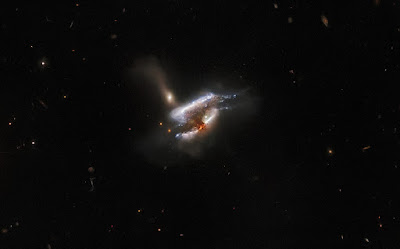Hubble transmitted the image of three galaxies colliding with each other on Earth Array
This week's image of the Hubble Space Telescope shows at least three galaxies in the process of colliding and transforming into a new galaxy called IC2431 . The galaxy is located in the sky in the constellation of Cancer, 681 million light-years away. By studying IC2431, we can understand how new galaxies form when they collide with each other.
Galaxy IC 2431
In the center of the image is a thick dust formed by the collision of these three galaxies . A strong gravitational pull from the center of these galaxies transforms their dust and stars into interesting shapes, and a new galaxy is born. In addition, new stars are emerging in this chaotic process. Many things may be happening at the center of the galaxy, but thick dust prevents them from being seen. Also, the bright light to the right of this dust can be seen from a galaxy several light-years away.
Galactic Zoo Project
This galaxy is one of a series of Hubble observations in which strange and special galaxies have been observed and exhibited in the galactic science project " Galaxy Zoo". Some astronomers also took a closer look at unusual galaxies with Hubble's advanced camera to explore the sky. The Galactic Zoo began in 2007 and is the largest galaxy identification project today, with more than 100,000 volunteers able to classify 900,000 galaxies.
In just 175 days , the project did what an astronomer could complete in years of effort. In addition, this project led to a continuous flow of citizenship projects. Extensive studies of colliding galaxies and dwarf galaxies were later carried out in the Galactic Zoo project , leading to the discovery of a new class of tiny young galaxies.
 Main Page
Main Page
Comments